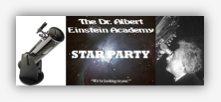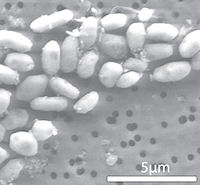 On the clear autumn night of Nov. 19, approximately 250 students and parents at Dr. Albert Einstein Academy, School #29, circulated among four activity stations relating to astronomy. The stations included telescope viewings of the moon, Jupiter and its moons, a virtual night sky tour in the planetarium, and two learning activity tables.
On the clear autumn night of Nov. 19, approximately 250 students and parents at Dr. Albert Einstein Academy, School #29, circulated among four activity stations relating to astronomy. The stations included telescope viewings of the moon, Jupiter and its moons, a virtual night sky tour in the planetarium, and two learning activity tables.
At the end of the evening, the night’s success was evident by the large number of parents and children who lingered, reluctant to leave. In fact, several parents asked when the next Astronomy Night is scheduled.
To learn more about how NASA Explorer Schools educator Tracy Espiritu and the teachers at the academy pulled off this successful astronomy night, read the Astronomy Night at School 29 post in the Ideas for family night events post in the ~Other NASA-related Activities I’ve Done forum in NEON.
 On Jan. 11, 2011, Google launched the inaugural Google Science Fair. Google has partnered with CERN, National Geographic, Scientific American and the LEGO Group to create this new STEM competition. This is a global competition open to any student aged 13-18, and students may enter as individuals or as teams of up to three. There is no entry fee. Registrations and submissions will be made online. The Science Fair will culminate in a celebratory event at Google headquarters in California in July 2011, where finalists will compete for internships, scholarships and prizes in front of a panel of celebrity scientist judges, including Nobel Laureates and household names.
On Jan. 11, 2011, Google launched the inaugural Google Science Fair. Google has partnered with CERN, National Geographic, Scientific American and the LEGO Group to create this new STEM competition. This is a global competition open to any student aged 13-18, and students may enter as individuals or as teams of up to three. There is no entry fee. Registrations and submissions will be made online. The Science Fair will culminate in a celebratory event at Google headquarters in California in July 2011, where finalists will compete for internships, scholarships and prizes in front of a panel of celebrity scientist judges, including Nobel Laureates and household names. On Jan. 11, 2011, Google launched the inaugural Google Science Fair. Google has partnered with CERN, National Geographic, Scientific American and the LEGO Group to create this new STEM competition. This is a global competition open to any student aged 13-18, and students may enter as individuals or as teams of up to three. There is no entry fee. Registrations and submissions will be made online. The Science Fair will culminate in a celebratory event at Google headquarters in California in July 2011, where finalists will compete for internships, scholarships and prizes in front of a panel of celebrity scientist judges, including Nobel Laureates and household names.
On Jan. 11, 2011, Google launched the inaugural Google Science Fair. Google has partnered with CERN, National Geographic, Scientific American and the LEGO Group to create this new STEM competition. This is a global competition open to any student aged 13-18, and students may enter as individuals or as teams of up to three. There is no entry fee. Registrations and submissions will be made online. The Science Fair will culminate in a celebratory event at Google headquarters in California in July 2011, where finalists will compete for internships, scholarships and prizes in front of a panel of celebrity scientist judges, including Nobel Laureates and household names.
 One of the most frequently asked questions of astronauts is about how and what they eat while in space. Expedition 26 Commander Scott Kelly recently made an informative video aboard the space station showing the food and beverage area, how food is prepared, menu options, and how they eat.
One of the most frequently asked questions of astronauts is about how and what they eat while in space. Expedition 26 Commander Scott Kelly recently made an informative video aboard the space station showing the food and beverage area, how food is prepared, menu options, and how they eat. Have you ever wondered what various geographic locations on Earth would look like from space?
Have you ever wondered what various geographic locations on Earth would look like from space?  On the clear autumn night of Nov. 19, approximately 250 students and parents at
On the clear autumn night of Nov. 19, approximately 250 students and parents at  Wouldn’t it be great to have a stop-action camera that could document the growth of your students’ plants in the NASA Explorer Schools module, Lunar Plant Growth Chamber? What might be other possible classroom uses for such a camera?
Wouldn’t it be great to have a stop-action camera that could document the growth of your students’ plants in the NASA Explorer Schools module, Lunar Plant Growth Chamber? What might be other possible classroom uses for such a camera? Headquarters in Washington. “As we pursue our efforts to seek signs of life in the solar system, we have to think more broadly, more diversely and consider life as we do not know it.”
Headquarters in Washington. “As we pursue our efforts to seek signs of life in the solar system, we have to think more broadly, more diversely and consider life as we do not know it.” Each day a different image or photograph of our fascinating universe is featured, along with a brief explanation written by a professional astronomer.
Each day a different image or photograph of our fascinating universe is featured, along with a brief explanation written by a professional astronomer.
 During this unique episode of NASA Now, astronaut and veteran spacewalker Mike Foreman describes his experiences from liftoff to living and working in space.
During this unique episode of NASA Now, astronaut and veteran spacewalker Mike Foreman describes his experiences from liftoff to living and working in space.